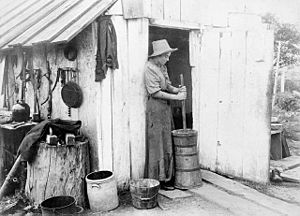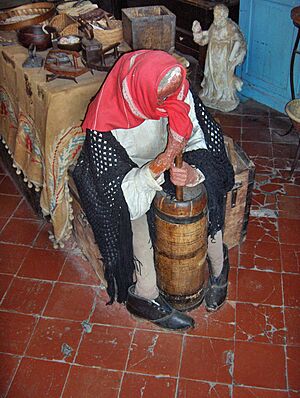Churning (butter) facts for kids
Churning is a special way of shaking up cream or whole milk. This process helps turn the liquid into butter. People usually do this using a tool called a butter churn. For a long time, from the Middle Ages until the Industrial Revolution, churns were simple barrels with a stick inside. People moved the stick by hand. Now, most churning is done with machines.
Butter is basically the fat part of milk. It's usually made from sweet cream, which is cream skimmed off the top of milk. In some countries like the USA, Ireland, the UK, and Nordic countries, people often add salt to butter. In most of Europe, unsalted butter is more common. Butter can also be made from cream that has been made a little sour. For many years, people just let cream sit and get naturally sour before making butter. Then, they would skim the cream off the milk and put it into a wooden tub.
In the past, making butter was all done by hand in butter churns. But letting cream sour naturally could be tricky. Sometimes, tiny living things called microorganisms would get in and spoil the butter. Today, making butter in factories is much better. This is because we've learned a lot about being clean (hygiene), using helpful bacteria, and heating the cream correctly. Also, machines have gotten much better. For example, machines that separate cream from milk were invented in the late 1800s. And machines that churn butter continuously became common by the mid-1900s.
How Butter is Made
Turning milk into butter is like changing one type of liquid mix into another. Milk is mostly tiny fat drops floating in water. Butter is mostly water drops floating in fat. In milk, the tiny fat drops are covered by a thin layer that keeps them separate.
Butter is made from cream that has been taken out of whole milk and then cooled. Fat drops stick together more easily when they are hard, not soft. But making good butter also depends on other things, like how much fat is in the cream and how sour it is.
Here are the main steps to make butter:
- Shaking the Cream: Churning means shaking the cream. This shaking breaks the thin layers around the milk fat drops. Once these layers are broken, the fat drops can join together and form bigger clumps of fat.
- Forming Butter and Buttermilk: As you keep churning, the fat clumps get bigger. They start to connect with air bubbles created by the churning. This traps the liquid and makes a foam. As the fat clumps grow, there are fewer air bubbles to hold. So, the bubbles pop, and the foam starts to leak liquid. This liquid is called buttermilk.
- Finishing the Butter: The cream separates into solid butter and liquid buttermilk. The buttermilk is drained away. The butter that's left is then kneaded. This kneading makes the fat crystals connect and gives butter its smooth texture. Working the butter also makes the tiny water drops spread out evenly in the fat. This makes the butter feel dry. After this, it can be shaped and sold.
Types of Butter Churns
Butter churns have changed a lot over time as new tools and materials became available.
- In the very beginning, people might have put cream in a container made from animal parts and shaken it until butter formed. Later, they used containers made of wood, glass, ceramic, or metal.
- The first common butter churns used a wooden container and a plunger. The plunger was pushed up and down to shake the cream until butter appeared.
- Later churns used containers made of wood, ceramic, or metal coated with zinc. These had paddles inside. People would turn a handle to make the paddles spin quickly through the cream. This mixed air into the cream and helped the butter form faster than just shaking it.
- Modern machines use a method called centrifugal separation. Instead of spinning paddles, the container itself spins very fast. This helps separate the butter from the buttermilk and water even better.
You can even make small amounts of butter at home by hand. You just need a good-sized container, like a Mason jar, and some strong shaking!
Today, many homes have electric mixers and food processors. People can use these small appliances to mix cream until it almost turns into solid butter. Then, they usually mix it by hand a little more to get rid of the buttermilk and extra water.





